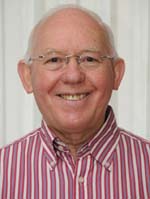The story
|
|
 Michel Vanlint
Michel Vanlint |
Zoutleeuw : This time did I have an appointment with one of the most fanatical fanciers in Belgium? If you ask me, yes. And certainly when, a few hours later, I closed the door of the house at #33 Bogaerdenstraat, I was more convinced of my opinion than before. Michel and his nice wife know perfectly what they are doing with their birds. For them, the pigeon sport is more than just a hobby. Every detail that could have an effect on a better race result is fanatically worked out. Even more, everything is done so well that you get that impression that here in Zoutleeuw, nothing can go wrong. Their success formula: superb birds housed in ideal lofts, managed by a top fancier.
|
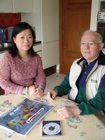 Van Lint at home
Van Lint at home
with his wife |
Only three years ago, Michel came back from Taiwan after being away for 20 years, and now he already has results that are what a lot of other fanciers can only dream of. National victories, Olympiad birds, etc. This is the pigeon sport from another planet, of playing at the pigeon sport just a little bit better-the pigeon sport as practiced by Michel Van Lint.
|
 Adonis
Adonis |
A SPECIAL GUY
Michel was born in 1935 as the youngest child of eight, into a real "pigeon family." Something would have had to go seriously wrong for Michel not to get infected with the "pigeon virus," because both his father Richard and his brothers were good fanciers. Certainly brother Firmin was a top short-distance fancier. The number of first prizes he clocked during his career as a fancier cannot be counted. Michel didn't get the opportunity to be in the pigeon lofts a lot, because as a little guy he went to a special school where he had to stay the whole week and week-ends. Only during the holidays, could the boarding students go home.
|

Agnes

Amanda
|
A strong regime was the first lesson in "how hard life can be." But when Michel did too many "bad things," he could not go home for the holidays and had to stay at school. "Och," Michel says, "when I had to stay, a teacher had to also stay and that was also a kind of punishment for those people. The result was that on Sunday afternoon we went to the soccer matches. Stade Leuven was then playing in first division and almost every home match I was sitting with a school teacher between the fans of that soccer club. In that stadium I decided to become a soccer player, and I think I may say that I was a good player." My coach would say 'You're a head too little, but you have character,' and I scored one goal after the other. When I celebrated my 30th birthday, I stopped playing soccer, and one week later I became an official pigeon fancier."
|

Amos
|
Michel goes on to say, "It is not that I want to boast about myself, but already then (and I am speaking about the year 1966) I was always looking for better pigeons and methods. Already then I raced my young cocks on widowhood coupled against old hens. Also my loft was unique for that period. Not only it was built in a southeasterly direction, but there was a special ventilation system and a heating system in the lofts. It was a loft in which I could 'play' with each weather situation. The strain of pigeons I had in these lofts was that of Genette X Delbar X Desmet Matthijs. I had a widowers' team of nine cocks and with them I succeeded in becoming 7th general Champion of Belgium."
|

Angelo

Anastasia
|
Advance nine years. 1980 was a real disaster of a year. Not only were Van Lint's best pigeons stolen but his loft was set on fire. Michel remembers, "I debated a lot whether to begin again with pigeons. Professionally, I had built up a very nice career in banking, and I didn't have a lot free time for the pigeons. But the 'pigeon virus' was not yet dead in me, and six months later I constructed a new loft using a special concept. The end result was a superb loft with ideal ventilation. In 1981, I started again with youngbirds, and in 1982 everybody wondered about my result on the Limoges national race for yearbirds. In total I basketted 24 yearbirds, and all the ring numbers were registered on the race result sheet."
|

Anita
|
TAIWAN
In 1978 Michel flew with some other business partners on trade mission to China. And while Michel is telling this, he shows me a blue brochure in which everything is well explained. But Michel made something special of this trip. Instead of staying the entire time with his colleagues, he left them for eight days. He made a first visit to Edourd Chien, his Taiwanese friend and vice-president of the Hua-nan bank , one of the biggest banks in Taiwan. Later he went with Chien to the lofts of a lot of other fanciers. Already then he felt a big need for Belgian birds and pigeon products.
|
 Attila
Attila
|
In October 1982 he made the definitive step. The combination of familial problems, the illness of a good friend, and the offer of Taiwanese pigeon fancier Johnson to become his loft manager in Taiwan convinced Michel move to there. The first year Michel raced very well with pigeons, but quickly he felt that he was seen as a "outsider." Van Lint felt a strong cultural difference from the Taiwanese people, and in that period they lived also under a special regime. The agreement with Johnson ended, and Michel moved to a little apartment above a shopping center. Michel reminds me, "Please note that I didn't have a wealthy and happy life. I didn't know a word of the language. Luckily, I got the support of my friend Chien. But I remembered the words of my soccer coach ('You have character'), and I went to the university to learn the language and culture. Can you imagine the situation? An 'old' European guy mixed in with all that Taiwanese youth-those were special times. But I succeeded, and I built up a nice business in buying and selling top Belgian pigeons and products.
|
 Vanlint inside
Vanlint inside
his loft
|
HOME SWEET HOME
"I never had the idea to stay forever in Taiwan," Van Lint recalls, "and during the last years, I was thinking more and more of going back to Belgium. With the support of Willem De Bruyn, I decided with my wife and daughter to go back to Belgium. On one of our visits to Belgium, we looked for a new home and one day we saw this house. The only thing I did was to look to see how I could build the ideal loft. When that idea came together, I told the realtor 'OK, we'll buy it.' My wife said, 'Wait a minute! You decided already and we haven't even seen the inside of the house?'"
|
 Hens' loft and
Hens' loft and
cocks' loft

Inside the
stockbird loft
|
Van Lint explains, "I engaged Van Ostaeyen to build my loft, following the concept of Huyskens-Van Riel. I wanted a loft built in an L-shape (12 meters by 18 meters), and it had to be built with the best materials."
"Having no stockbirds," Michel explains, "I had to start with pigeons from my European friends. I received 50 youngsters from Willem De Bruyn (Reeuwijk), 24 pigeons from Herbots Gebroeders (Halle-Booienhoven), 15 pigeons from Oliviers-De Vos (Kumtich), and 18 pigeons from De Keyser (Erps-Kwerps). One year later, I received 30 more pigeons from Willem and 15 from Filip Herbots. I raced all of the birds, and only the best got a ticket for the breeding loft that year."
|

The aviary for
the stockbirds

The special
breeding boxes

Special boxes for
the breeders

A view of the
racing loft |
TOTAL WIDOWHOOD
The pigeon sport is a tough sport, and pigeons who are born in the loft of Michel Van Lint may not assume they will have an easy life. No, flying a lot of kilometers is the message. From the first Sunday of April until the last national race in September, each week the old and year birds see the inside of a basket, and this is for races between 350 and 620 kilometers. This is a system which is not ideal for every bird, and those who can't follow are selected out."
Total widowhood is the system, and therefore four compartments are built--two for the cocks and two for the hens. For the 2005 season the team is made up of 32 widowers and 32 hens. At the end of December they were coupled, and when the youngsters were 10 to 12 days old, the hens went with the youngsters to the youngbird loft. They were separated so early because Michel thought the hens would lay quickly a second time."
Once the youngsters and hens are moved to another loft, there is a kind of winter regimen for the widowers. Depure Plus I.C. is given as feed, together with a small percentage of Superstar Plus I.C. How much? A good soupspoon per day and per pigeon and this is fed three times. Natural products like garlic, tea, etc., go into the drinkers every day, and Michel isn't afraid to create winter condition.
Michel explains, "These natural products are very good for creating a very good basic condition. We're now at the end of February and the pigeons train vigorously for one hour. The droppings are more than perfect, and that is a sign that everything is all right."
"It is important during this period to drill the pigeons. Pigeons are animals and animals can be trained. With a 'drill-stick' in the hand, I make sure that every bird stays in his box or that every bird enters the right loft through the right sputnik."
|
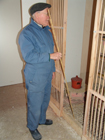
The drilling
stick
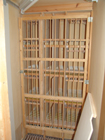
The compartment
for the racing hens
|
EXTRA TRAINING
"Once the season is started," Michel continues, "no effort is too much for the birds. No detail may be ignored, and everything is done very punctually. A second coupling for the 32 cocks and 32 hens is scheduled around March 10th on the program. After a few days of brooding, the take off for the new season is given."
"To explain our system clearly," Michel goes on to say, "I have to explain more specifically the loft. It is built so that there are two sections for the cocks and two sections for the hens. First a section for the cocks, then a little one for the hens, again one for the cocks, and at last a little one for the hens. Early in the morning, the hens do their first training. When they're outside to train, the cocks are moved to the hens' section. After one hour, when they have trained, the hens enter the loft and are fed and have the opportunity to drink.
Meanwhile, the cocks go out. When the hens have finished eating and drinking, they are moved to their hens' section. Again after one hour, the cocks enter the loft, and they get also something to eat and drink. The lofts are identical, and to be sure that every cock and hen enters the right loft they have a colored chip ring. Green rings into the green loft, blue into the blue loft, etc., so there is never a 'stranger' in the loft. The trainings are done twice a day."
|

A dropper to attract
the incoming birds

Inside the
youngbird loft

The youngbirds of
the second round

Michel outside by
the youngbirds
|
As I've already written, a great deal of effort is put into preparing these birds. Although there are training excursions around the loft twice a day and weekly races, Michel also makes two or three training tosses of 30-40 kilometers each week. The purpose is to teach the pigeons to take immediately a good direction. It is not the bird that makes the highest velocity who wins, but it is the pigeon who takes the best direction who is the winner. Orientation has a lot to do with "immediately taking the right direction." After a few training tosses, you see that the birds go quickly in a good direction. The hens are liberated first and 20 seconds later the cocks.
Michel continues, "By the time of arrival, the cocks and hens are together, and my wife makes sure that every cock and hen enters the right loft. With the 'drill-stick' in the hand, she shows every bird its loft. Do you now understand why it is important to drill the birds very well during the winter period? Before I forget, after this training toss the birds are fed again."
Van Lint asserts, "Those fanciers who expect a lot of their birds must make sure that their birds have everything to be successful. In first place there is the medical part. I work with veterinarian Raf Herbots. I follow his advice. Don't ask me about a fixed system, because for me that doesn't exist. Everything depends on the situation. I cannot not imagine that you know already months in advance what you must do against which disease."
"In my feeding routine, I can say that I work with three different mixtures," Van Lint goes on. "First, there is Start Plus I.C., a breeding mixture for the beginning of the week. Then there is Superstar Plus I.C., a widower mixture with a little French mais for the middle of the week. Then there is Energy Plus I.C. with mais (a mixture very rich in fats with peeled sunflowers, etc.) for the end of the week. Again don't ask me how much I feed, because it all depends on the weather conditions, the condition of the pigeons, etc. I feed until a few birds go to the drinker. Feeding is an art, and it is up to the fancier to see if the pigeons have enough or not. It is not that I don't want to explain it. It is just not possible to do."
|
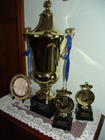
Some of Michel's
important trophies
|
YOUNGBIRDS
Michel Van Lint is the man to beat not only with old and yearbirds, but also with youngbirds. The first and second rounds are good for 120 youngsters, and for this group there is only one law-putting top results on paper. From the moment they're weaned, the youngsters have to follow a certain system. One of the rules is that they have to listen. Michel is the boss and not them. When they're called in, they have to enter the loft immediately or there will be no food on table. Also the youngbirds are drilled with a stick. The youngbirds are raced following the "open-door-system."
TOP RESULTS 2004
It is important to know that in 2004, Michel raced with only 18 hens and 18 cocks.
04-18-04 Laon (163km): 282b.: 1-4-27 etc.
682b.: 1-9 etc.
04-25-04 Soissons (195km): 423b.: 1-3-6-7-8-12-14-18-23-27-29-33-58 etc.
05-01-04 Pithiviers (362km) 1070b.: 1-2-3-5-9-10-12-13-35-53-55-74-92-102 etc.
05-22-04 Vierzon (460km) 231b.: 1-4-5-8-9-14-16-17-23-24-
27-31-40-50 etc.
05-29-04 Bourges (465km) 346b.: 1-2-3-5-8-12-27-29-31-35 etc.
06-05-04 Blois (454km): 1-2-3-4-5-6-7-8-9-11-17-21-24-27-38-
39-42-50 etc.
06-12-04 Chateauroux (511km): 472b.: 1-2-4-5-6-7-8-9-10-12-18-26-31-32-48-53-76
06-19-04 Bourges 166b.: 1-2-7-8-9-10-15-17-18-28-29-31 etc.
06-26-04 Montlucon (531km) 237b.: 1-3-4-7-9-13-14-16-17-20-23-26- etc.
07-03-04 La Souterraine (576km) 171b.: 2-4-5-6-7-8-9-11-12-21 etc.
07-10-04 Argenton (540km) 3159b.: 1-4-5-8-11-18-28-49-68 etc.
6986b.: 1-7-9-11-18 etc.
07-17-04 Limoges (618km) 159b.: 2-3-4-7-13-15 etc.
24-07-04 Toury : 466b.: 1-3-4-9-10-11-24-27-30-39-42-47-48 etc.
07-31-04 Bourges 4372b.: 12-24-28-31-43-65 etc.
429 youngsters: 3-4-8-19-27-31-36-39-48-51-52 etc.
08-08-04 Toury 264b.: 2-3-7-8-9-15-28-31-etc.
08-14-04 Argenton 1445b.: 1-5-6-8-18-25-26-27-57-58-79-88 etc.
national yearbirds 3949b.: 3-9-12-24-37-45-46-47 etc.
national youngbirds: 23.010b.: 13-21-45 etc.
08-21-04 Bourges 1541 youngsters: 7-8-46-88-103-116-145
08-28-04 La Souterraine 1361b.: 1-2-5-16-26-29-50-58-87-95-113-136
national 3096b.: 1-4-8-36-53-73-81 etc.
09-11-04 Vichy (537km): national 2460 old birds: 1-2-9-26-45-46-47 etc.
national 11296 youngsters: 12-30-71 etc.
|
| Author : Stefan Mertens |
| |
| |
| |
| |
| |
|
|
|
|

